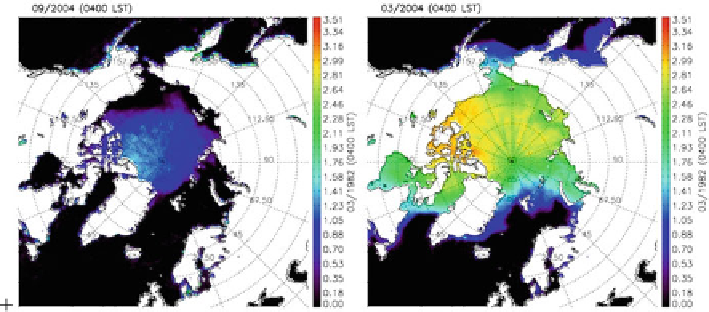Environmental Engineering Reference
In-Depth Information
Fig. 9.12
September (
left
) and March (
right
) 2004 sea ice thickness (04:00 local solar time)
estimated with the energy budget approach of Wang et al. (
2010
) using AVHRR data
reached orbit. Although ICESat may not be sensitive enough to obtain precise ice
thickness estimates, it has made a significant step toward routine observation of ice
thickness from space, with reasonable basin-wide thickness distribution fields having
been produced during intervals of laser operation. CryoSat-2 is now operating well
and provides valuable information on sea ice thickness. The combination of laser and
radar altimeters can provide an estimate of snow depth on ice, because the radar
signal generally comes from the snow-ice interface and the laser signal comes from
the top of the snow cover.
Another approach to estimating ice thickness is to use satellite-derived cloud and
surface properties with a surface energy budget model to solve for ice thickness.
Wang et al. (
2010
) developed such a method (Fig.
9.12
). It is currently being applied
to the relatively long time series of AVHRR data for studies of recent trends.
Acknowledgements
This work was supported by the National Oceanic and Atmospheric Admin-
istration (NOAA) Arctic Research Office, NASA, and the National Science Foundation.
David Santek and Richard Dworak contributed to the research on polar winds. Walt Meier
and Don Cline provided input on sea ice and snow cover, respectively. The views, opinions,
and findings contained in this report are those of the author(s) and should not be construed as an
official National Oceanic and Atmospheric Administration or US government position, policy,
or decision.
References
ACIA (2005) Arctic climate impact assessment: impacts of a warming arctic. Cambridge Univer-
sity Press, Cambridge
AMAP (2011) Snow, water, ice, and permafrost in the Arctic (SWIPA): climate change and the
cryosphere. Arctic Monitoring and Assessment Programme, Oslo, p 538

Search WWH ::

Custom Search